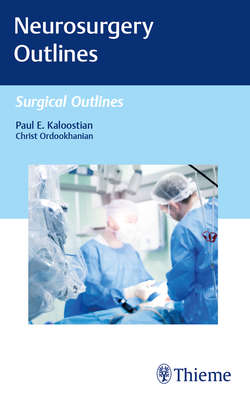Читать книгу Neurosurgery Outlines - Paul E. Kaloostian - Страница 68
На сайте Литреса книга снята с продажи.
Surgical Procedure for Posterior Thoracic Spine
Оглавление1. Informed consent signed, preoperative labs normal, no Aspirin/Plavix/Coumadin/NSAIDs/Advil/Celebrex/Ibuprofen/Motrin/Naprosyn/Aleve/other anticoagulants and anti-inflammatory drugs for at least 2 weeks
2. Appropriate intubation and sedation and lines (if necessary) as per the anesthetist
3. Patient placed prone on Jackson Table with all pressure points padded
4. Neuromonitoring may be required to monitor nerves (if necessary and indicated)
5. Time out is performed with agreement from everyone in the room for correct patient and correct surgery with consent signed
6. Make an incision down the midline of back
7. Subperiosteal dissection of muscles bilaterally exposing the spinous process and paraspinal muscles
8. Dissect tissue planes along spinous process and laminae using rongeurs
9. Move paraspinal muscles laterally to expose the laminae
10. Once the locus of interest is exposed, it is best to localize and verify the correct vertebra via X-ray or fluoroscopic imaging and confirming with at least two people in the room
11. Perform the decompression procedure over segments needed based on preoperative imaging of levels that are compressed due to trauma:
a. Using Leksell rongeurs and hand-held high-speed drill, remove the bony spinous process and bilateral lamina as indicated for specific procedure (laminectomy)
b. Or, remove bone of lamina above and below spinal nerves to create a small opening of lamina, relieving compression (laminotomy)
c. If compression is diagnosed to be from spondylolisthesis, a diskectomy is performed (remove portion of slipped disk)
d. Remove the thick ligamentum flavum and any bone spurs with Kerrison rongeurs with careful dissection beneath the ligament to ensure no adhesions exist to dura mater below and thus avoiding cerebrospinal fluid (CSF) leak
e. Perform appropriate foraminotomy with Kerrison rongeurs as needed for appropriate decompression of nerve roots
12. Perform spinal fusion with instrumentation (often needed in trauma cases):
a. Place pedicle screws over segments involved with connecting rods bilaterally, in addition to bone grafting, to fuse these segments (see ▶Fig. 2.2 and Fig. 2.3)
13. After appropriate hemostasis is obtained, muscle and skin incisions can then be closed in appropriate fashion, often with placement of postoperative drains that can be removed after 2 to 3 days
Fig. 2.2 (a) Patient placed in lateral decubitus position in preparation for a transthoracic vertebrectomy approach for decompression and fusion in response to thoracic trauma. Dashed lines represent levels of incision for the following thoracic segments: T10–T12, T5–T9, and T1–T4. (b) For dissection, electrocautery is employed to transect muscle. The rib is visualized and resected. After visualizing the neurovascular bundle, ligate and cut it. (c) The vertebrectomy is performed by removing the vertebral body and the surrounding disks with a drill and Kerrison rongeurs. Avoid damage to the thecal sac for decompression. (d) Following vertebrectomy, fusion is performed with instrumentation for stabilization. An autograft, allograft, or cage may be used. Place a plate and screws for proper fixation. (Source: Operative procedure. In: Ullman J, Raksin P, eds. Atlas of Emergency Neurosurgery. 1st ed. Thieme; 2015).
Fig. 2.3 (a, b) Illustration of thoracic fusion and instrumentation with an expandable cage in a thoracic trauma patient. Fusion was preceded by a thoracic corpectomy. (Source: Anteri- or thoracic arthrodesis after corpectomy (expandable cages, metallic mesh cages). In: Vaccaro A, Albert T, eds. Spine Surgery: Tricks of the Trade. 3rd eds. Thieme; 2016).
